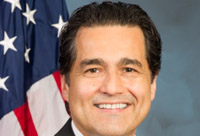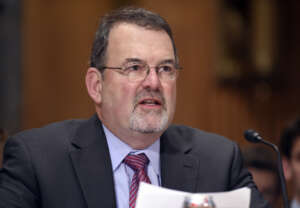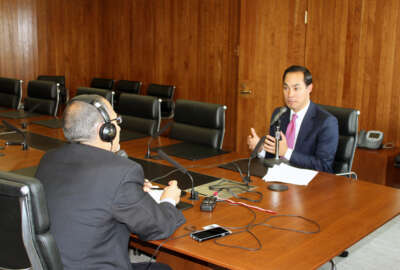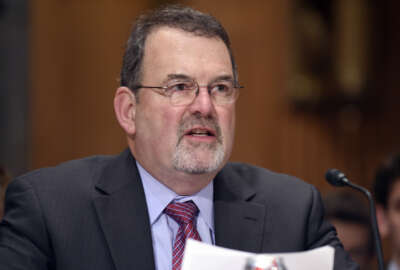
The state of federal technology: ‘A crisis bigger than Y2K’
Federal chief information officer Tony Scott said agencies are spending too much of their money on legacy technology that can’t easily be secured, and the peo...
Federal Chief Information Officer Tony Scott said he believes one of the biggest challenges agencies are facing today is around legacy IT systems.
Scott said the use of decades old systems impacts cybersecurity, mission effectiveness and the ability to be more mobile.
“We are facing a crisis that is bigger than Y2K. It’s just there is no Dec. 31, 1999. Much of the government today runs on very old, outdated technology. The people that understand it, who built it and are running it are leaving every day. We are not building capacity with those skill sets,” Scott said Nov. 16 at the President’s Management Advisory Board meeting in Washington. “And just to do a lift and shift with those old architectures is the wrong answer. Moving to a more shared infrastructure, shared capability is probably a better model, one that is cloud based. But it will take some significant transformation and significant re-architecting of what we have.”

There are several reasons why Scott said the state of federal IT is at a crisis point. First and foremost, agencies are spending more of their IT budgets to support these old hardware and software systems. Scott has said previously that figure is inching up to 80 percent or more after being on the down swing over the last few years.
Second, as the Office of Personnel Management found out, securing these systems is getting harder and harder. Scott said the current architectures are not built with security at the forefront, and keeping them protected and current is getting more difficult each year.
Finally, the federal appropriations process doesn’t support agencies’ move off of legacy systems. Scott said the idea that it’s easier to spend money on older systems than on new ones has to be turned on its head.
Scott, who also spoke Nov. 17 at the FedTalks conference, sponsored by FedScoop in Washington, said agencies need to change both the architecture and process by which it builds and secures systems.
“There is a lot of modernization that has to take place, and it won’t happen just by people haranguing us to either save money or move faster,” he said. “We have to have a theory of operation. We have to have some experiments that will help us figure out what’s the best way to move off some of the legacy architectures, and move more quickly to modernize this core set of applications and infrastructure that we’re all challenged with.”
Scott has promised new guidance and possibly incentives to move agency spending out of legacy systems and into new or modernized systems.
In fact, this was a common theme from almost every CIO who spoke at the event — modernization has to happen sooner than later.
Take the Department of Housing and Urban Development. It is about to kick into high gear a new transformation effort.
Rafael Diaz, the HUD CIO, said his office held an industry day for its IT transformation project called HUD Enterprise Architecture Transformation (HEAT) on Nov. 17. HUD plans to release a solicitation for the first piece of HEAT in the coming weeks.
“One of the foundations is, of course, your infrastructure. So how do we look at that infrastructure and ensure we are providing a robust, state-of-the-art, up-to-date, to five ‘9s’ available infrastructure for HUD’s services,” said Diaz after he spoke at the FedTalks event. “We are moving to shared services. We went to the Federal Strategic Sourcing Initiative contract with the General Services Administration. We are looking at a [multiple award contract] for a systems integration contract we are putting out. And then, we are looking at how do we move the data center and what is the best vehicle for that, and who is the best partner to help us to move that data center to a federal shared services data center?”
Diaz said the HEAT program includes multiple components, starting with systems integration, which includes several components such as end-user support, disaster integration and understanding how systems are integrated.
As for the data center contract, Diaz said the incumbent, HP, likely will receive an extension as HUD considers its options.
“How will we partner with different organizations to help us, to train us for agile and dev/ops? We are looking at multiple capabilities there to bring digital services into HUD,” he said.
Related Stories

Castro aims to improve HUD’s IT environment

Federal CIO Tony Scott instills a sense of urgency to move from older IT

The state of federal technology: ‘A crisis bigger than Y2K’
While HEAT is a major program for HUD, Diaz said transformation is an ongoing effort.
He said the agency almost has completed moving its email and collaboration suite to the Microsoft cloud.
“We are looking at rolling out a customer relationship management project for the homeownership center help desk in the cloud,” Diaz said. “There are a number of other projects we are working on like the loan review system, the Affirmatively Furthering Fair Housing rule and Section 8 voucher management systems. HEAT is the foundation, but it’s only one component of the change that is going on at HUD right now. It certainly will accelerate in 2016 as we move forward with these contracts.”
HUD isn’t alone in trying to transform its legacy IT systems. At the Patent and Trademark Office, John Owens, the CIO, said he’s getting out of hiring systems integrators and is bringing those capabilities in house. His office is overseeing the ongoing move to agile development for software.
At the Environmental Protection Agency, Ann Duncan, the CIO, said she is moving mission critical systems to the cloud, including the central data exchange (CDX) program to a hybrid instance that includes the agency’s data center and Microsoft’s Azure cloud.
And finally at the Social Security Administration, deputy CIO Herb Strauss is trying to come to terms with an application install base of 700 software titles, some of which live on hardware that is 30 years old or more. He said SSA is facing a silver tsunami, which will raise its customer base by 18 million people over the next five years. Strauss said transformation has to happen both from a technology and business perspective.
Copyright © 2024 Federal News Network. All rights reserved. This website is not intended for users located within the European Economic Area.
Jason Miller is executive editor of Federal News Network and directs news coverage on the people, policy and programs of the federal government.
Follow @jmillerWFED



